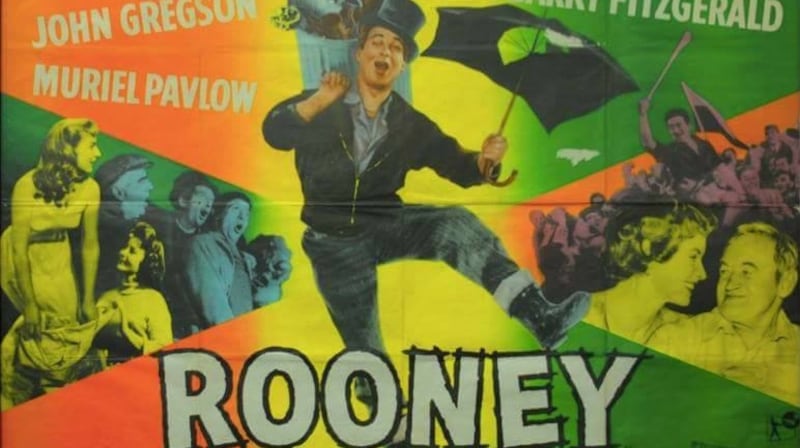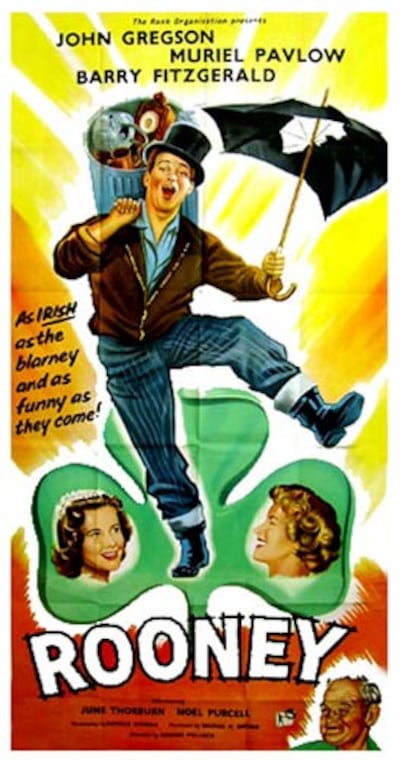It opened 63 years ago, this coming Saturday (March 13th), just in time for St Patrick’s Day. Shot in Dublin with throngs of local actors, Rooney has the distinction for an international release of featuring an All-Ireland final - in this case the 1957 meeting of the hurlers from Kilkenny and Waterford.
You wouldn’t want to let that mislead you. The scenes from Croke Park are part of a clunky plot device that requires Dublin bin-man James Ignatius Rooney to line out in an All-Ireland for his county - in between a series of romantic adventures.
Yet it was all the rage. Newspaper articles tracked its making and when it appeared on Irish screens, the public response was overwhelming. In its first four days at Dublin’s Savoy, then a one-screen cinema with a vast auditorium, 30,000 watched and it broke the one-day attendance record with 10,000 customers.
The story is adapted from a novel by Catherine Cookson, whose work is rooted in the North-East of England, and transplanted to Dublin. So was he a soccer player in the original story? No. There was no sporting angle. That was added - as happened occasionally at the time with a motif as usefully Oirish as hurling - to provide extra whimsy.
Seán Crosson, from the Huston School of Film in NUI Galway, has literally written the book on it. Author of Gaelic Games on Film: From silent films to Hollywood hurling, horror and the emergence of Irish cinema (Cork University Press, 2019), he devoted a chapter to 'Rooney' and says that it had a significant impact in the country.
“It struck a chord. It broke box-office records in Dublin and across the country. It was marketed as ‘record breaking’ but reflected as well a moment in Ireland. There wasn’t a huge amount of film focused on this country so there was a lot of media attention on the production itself.
“Its uniqueness is that it has a hurling playing lead protagonist. There’s nothing else like that. John Gregson is a well-known actor of the time. In terms of the book the only parallels are that the character is a bin-man and is much sought after by landladies!”
Overseas production
Breaking Ball, the RTÉ series on Gaelic games, interviewed the late Maureen Toal just under 20 years ago and she spoke of the excitement that the arrival of an immensely popular British screen presence like Gregson caused in the Dublin of the late 1950s.

For all the prominent Irish actors - Barry Fitzgerald and Jack MacGowran had been in The Quiet Man - and the locations, it’s an overseas production. Director George Pollock and producer George H Brown (who was Maureen O’Hara’s first husband and father of journalist Tina) are English as are the romantic leads, Gregson and Muriel Pavlow - both slightly long in the tooth for their roles but it zips along its faintly ludicrous narrative arc in engaging enough fashion.
The Irish Times of the 1950s was still a few years shy of setting aside its world view of Dublin as a provincial British city but even by those standards, the paper’s review is curious. It’s the lead item in the cinema section but makes no reference to the hurling element of the story and boldly declares: “There is nothing stage Irish about Rooney”.
You don’t have to go as far as writer Eamonn Sweeney, who in the above Breaking Ball piece said that Rooney “was the most stage-Irish film of all time . . . [making] Darby O’Gill and the Land of the Little People look like a documentary,” to know that the other extreme isn’t really tenable.
To be fair to the unidentified Irish Times reviewer, the assertion is placed in context by pointing out that by the standards of British cinematic treatment of Ireland, Rooney wasn’t that bad and then damningly - and not unfairly - that it was even culturally familiar.
“It is quite a well told-story,” runs the review, “which could quite easily have been taken direct from one or other of a succession of Abbey Theatre comedy successes during the past few years.”
Like a few films, its’ most enduring significance is in its preservation of its own time: the shots of the hurling final and scenes from Dublin, opening with an Irish Press van in O’Connell Street and inevitably Guinness’s brewery.
There’s a diddley-aye song, written by Tommie Connor (who also wrote, I Saw Mommy Kissing Santa Claus), Rooney-O, which preposterously recurs like some musical motif during the film, including when the protagonist’s work colleagues lustily serenade him in the back of their bin lorry.
The hurling element isn’t actually that bad although there are plenty of holes - Dublin playing in Kilkenny colours to take one of the more obvious.
The idea of a player being a late call-up for an All-Ireland is unlikely but not off the scales over 60 years ago when so few championship matches were played. If some of it looks quaint, it is of its time - a reporter calls to his door with a photographer and is ushered in to demand of the surprise selection: “Tell us your story”.
Crosson says that the idea behind the story is commonplace, Hollywood material but equally undermined by its limitations.

“This idea of the ‘American dream,’ pulling yourself up by the bootstraps, overcoming challenges and achieving success – Rooney personifies that: the modest bin-man, who through sporting prowess achieves that trajectory.
“In Rooney it’s not fully realised because he just can’t play hurling! The guy’s hopeless and you look at him running and it’s unintentionally funny. The fact that they spent six hours in Croke Park so that he could score just one point! Normally the climax of a sporting film is the event itself but the producers could see that it just wasn’t going to work like that. It was just bizarre.”
Limited success
The production did its best with Gregson. Dessie Ferguson, a Dublin dual player and All-Ireland football medallist, tried to teach the Liverpool actor how to hold a hurl but with limited success.
Famously, Rooney appears as the 16th man in the pre-match parade at the 1957 final. Waterford were initially approached and declined but Kilkenny dug Croke Park out of a hole - the association was keen enough on a cinematic representation of its big day - by allowing it.
“The GAA was involved in that process,” says Crosson. “Pádraig Ó Caoimh (GAA general secretary) was a board member of the National Film Institute and one of the instigators of the filming of the All-Ireland finals from 1948 on.
“He also appeared in the film Three Kisses, an Oscar-nominated short, which was the first time the GAA directly collaborated with a major studio. Ó Caoimh was undoubtedly involved in Rooney as well, as they couldn’t have had the access otherwise.”
Kilkenny wing-back Johnny McGovern remembers the occasion well and how one of his team-mates was used as effectively a body double for the actor when they were asked back to complete some scenes and given a fiver for their troubles.
“John Gregson took part in the parade with the Kilkenny team. In the film he played a Dublin council operative, who played hurling. The teams went back for more filming the following day. We were up at one end of the field hurling. Denis Heaslip was selected to take the part of John Gregson. Denis was very good at solo running so there was a lot of that in the film.
“Denis was from Knocktopher and only died recently. We only won by one point. Mickey Kelly was the captain and he scored the winner.”
Gregson simply left the field after the parade and when again in Dublin for the Theatre Festival some 12 years later, laconically remembered the Croke Park experience as: “about 70,000 extras that the studio didn’t have to pay”.
The intercutting on the match scenes is more tree-felling than micro-surgery. Percussive metallic noises are weirdly added to emphasise the striking of the ball. Eventually, Rooney scores the winner, as is broadcast on radio as part of the film by Micheál O’Hehir.
“He was the voice of Gaelic games in Ireland for much of the 20th century and another point of recognition and appeal for an Irish audience,” says Crosson.
Not all reaction was positive. Benedict Kiely’s review in the Irish Press is very critical of a previous hurling scene - the match featuring Rooney’s fictitious club, Sons of Erin, which descends into a side-line brawl among supporters, re-awakening, says Crosson, a persistent issue for the GAA with screen depictions.
Controversial
“Immediately before Rooney was made there was an Oscar-nominated short about hurling, called Three Kisses and then in 1957, The Rising of the Moon, by John Ford which was very controversial in its depiction of hurling. There were no images of the game but post-match scenes were depicted of hurlers coming back on stretchers after a county final.
“The GAA sent a deputation to the set in county Clare and there was very strongly worded press releases from Croke Park. It also inspired a hilarious column by Myles na Goplaleen. Generally, Ford’s genius as a film maker is expressed by his ability to provide the stereotype but also the nuance.
“Rooney exploits the stereotypes but you don’t get the other layers. That’s why in any poll of favourite Irish films, you won’t see Rooney popping up but you’ll often see The Quiet Man. Even though those stereotypes are present they are interrogated within the film.”
It remains the only mainstream cinematic feature that focuses on an All-Ireland final. It’s available on YouTube and for all its comical melodrama, shines a light on Dublin in the 50s, a city on the cusp of the modern age.
“We have to put Rooney in context,” concludes Crosson. “It’s easy to look back and find faults because there are faults there but it was a work of its time and a work of its moment and that had a real importance and significance. In how it continues to capture its time and moment is where its greatest contemporary relevance still lies.”











